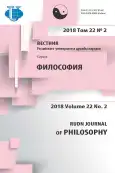Язык, мозг, вычисления: от семиотической асимметрии к рекурсивным правилам
- Авторы: Барышников П.Н.1
-
Учреждения:
- Пятигорский государственный университет
- Выпуск: Том 22, № 2 (2018)
- Страницы: 168-182
- Раздел: ОНТОЛОГИЯ И ТЕОРИЯ ПОЗНАНИЯ
- URL: https://journal-vniispk.ru/2313-2302/article/view/344834
- DOI: https://doi.org/10.22363/2313-2302-2018-22-2-168-182
- ID: 344834
Цитировать
Полный текст
Аннотация
Данная статья посвящена сравнительному анализу одной из наиболее влиятельных теоретических областей, использующей корреляционные принципы структурно-функциональной организации мозга и когнитивных характеристик естественного языка. Особая роль в данном подходе присваивается принципу вычислимости. В статье обсуждаются преимущества и недостатки модулярного и холистического подходов в контексте семиотической асимметрии. Важно отметить, что информационное представление языка в виде системы иерархически упорядоченных объектов хорошо сочетается с коннекционистской моделью мозга, в которой каждый вычисляющий элемент сети отвечает за определенные нейрональные функции. Такое методологическое упрощение создает ряд противоречий. В данной работе анализируются методологические основания нейросетевого подхода и принципы рекурсивной организации языковых процессов. Основной вопрос состоит в следующем: определяет ли структура нейронных связей процессы формирования ментальных репрезентаций и грамматические вычисления? Единообразие логико-синтаксической структуры нейронов в нейросетевых моделях порождает не вполне корректную гипотезу о том, что мозг - это нейросеть, способная к вычислению синтаксических и грамматических правил. Одна из целей данной статьи состоит в выявлении методологических противоречий, указывающих на особенности языковой структуры и принципов языковой деятельности, несогласующихся с вычислительными моделями.
Об авторах
Павел Николаевич Барышников
Пятигорский государственный университет
Автор, ответственный за переписку.
Email: pnbaryshnikov@pglu.ru
кандидат философских наук, доцент кафедры исторических и социально-философских дисциплин, востоковедения и теологии, руководитель Научно-образовательно-инновационной лаборатории «Методологический и проектно-аналитический центр междисциплинарного взаимодействия»
ул. Калинина, 9, Пятигорск, Россия 357500Список литературы
- Arbib, Michael A. 2010. Action to language via the mirror neuron system. Cambridge: Cambridge University Press.
- Arbib, Michael A., and G. Rizzolatti. 1998. Language within our grasp. Trends in Neuroscience 21: 188-194.
- Barulin, Anatoliy N. 2013. How it happened with you, Adam? Discussion about origin of language. Antropologicheskij forum 19: 300-326.
- Chafe, Wallace. 2008. The role of introspection, observation and experimentation in the interpretation of thought. In Computers, brain, cognition: success of the cognitive sciences, ed. BM. Velichkovskij and V Soloviyov, 163-178. Moscow: Nauka.
- Chernigovskaya, Tatiana V. 2004. Brain and language: a century and a half of investigation. In Teoreticheskie problemy jazykoznanija: Sb. st. k 140-letiju kaf. obshhego jazykoznanija SPbGU, ed. L.A. Verbickaja, 16-28. Saint Petersburg: Filol. fak-t SPbGU.
- Corballis, Michael C. 2011. The recursive mind. The origins of human language, thought, and civilization / Michael C. Corballis. Princeton, N.J., Woodstock: Princeton University Press.
- Deglin, Vadim L. 1996. Lectures about functional asymmetry of human brain. Amsterdam-Kiev.
- Dijk, Teun Adrianus van. 1981. Studies in the pragmatics of discourse. The Hague, New York: Mouton.
- Everett, Daniel. 2005. Cultural constraints on grammar and cognition in Piraha. Current Anthropology 46 (4): 621-646.
- Gentner, Timothy Q., Kimberly M. Fenn, Daniel Margoliash, and Howard C. Nusbaum. 2006. Recursive syntactic pattern learning by songbirds. Nature 440 (7088): 1204-1207.
- Hauser, Marc D., Noam Chomsky, and W. Tecumseh Fitch. 2002. The faculty of language: what is it, who has it, and how did it evolve? Science (New York, N.Y.) 298 (5598): 1569-1579. doi: 10.1126/science.298.5598.1569.
- Hickok, Gregory. 1993. Parallel Parsing: Evidence from Reactivation in Garden-Path Sentences. Journal of Psycholinguistic Research Journal of Psycholinguistic Research 22 (2): 239-250.
- Hofstadter, Douglas R. 1979. Gödel, Escher, Bach. An eternal golden braid. New York: Basic Books.
- Hulst, Harry van der. 2010. Re Recursion. In Recursion and human language, ed. Hulst, Harry van der, 15-53. Studies in generative grammar, vol. 104. Berlin, New York: De Gruyter Mouton.
- Isakadze, Natalia V. 1998. Reflection of morphology and nominal group referential semantics in the formal syntax. (Thesis) Diss.. kand. nauk. MGU im. Lomonosova, Moscow.
- Jackendoff, Ray, and Steven Pinker. 2005. The nature of the language faculty and its implications for evolution of language (Reply to Fitch, Hauser, and Chomsky). Cognition 97 (2): 211-225. doi: 10.1016/j.cognition.2005.04.006.
- Jackson, John H. 1874. On the nature of the duality of the brain. Medical Press and Circular (1).
- Jacobson, Roman. 1985. The linguistic types of aphasia. In Selected works, ed. Zvegincev V.A., 287-301. Moscow: Progress.
- Kibrik, Аlexander E. 2008. Cognitive approach to language. In Computers, brain, cognition: success of the cognitive sciences, ed. B.M. Velichkovskij and V. Soloviyov, 202-230. Moscow: Nauka.
- Krotkova, Olga A., and Boris M. Velichkovskij. 2008. Interhemispheric differences of thought under the lesion the higher gnostic areas of the brain. In Computers, brain, cognition: success of the cognitive sciences, ed. B. M. Velichkovskij and V. Soloviyov, 107-132. Moscow: Nauka.
- Lamb, Sydney M. 1999. Pathways of the brain. The neurocognitive basis of language. Amsterdam studies in the theory and history of linguistic science. Series IV, Current issues in linguistic theory, v. 170. Amsterdam, Philadelphia: J. Benjamins.
- Lamb, Sydney M. 2008. What data types are used in neurocognitive linguistics. In Computers, brain, cognition: success of the cognitive sciences, ed. B. M. Velichkovskij and V. Soloviyov, 180-201. Moscow: Nauka.
- Lotman, Yuri M. 1993. Brain-text-culture-artificial intelligence. In Selected works in 3 vol., vol. 1, 25-33. Tallinn: Alexandra.
- Luria Alexander R., and James V. Wertsch. 1981. Language and cognition. Washington, D.C., New York: V.H. Winston; J. Wiley.
- Panov, Evgueniy N. 2012. Paradox of continuity. Language Rubicon: on impassable gulf between the animal signal systems and the human language. Moscow: Jazyki slavjanskih kul'tur.
- Pinker, Steven. 2004. The language instinct. Moscow: Editorial URSS.
- Ramachandran, Vilayanur S. 2006. Broken mirrors a theory of autism. Scientific American 295 (5): 62-69.
- Rizzolatti, Giacomo, Corrado Sinigaglia, and Frances Anderson. 2008. Mirrors in the brain. How our minds share actions, emotions, and experience. Oxford: Oxford University Press.
- Schiffman, Harvey Richard. 2000. Sensation and perception. An integrated approach, 5th edn. New York: Wiley.
Дополнительные файлы









